America - Australia
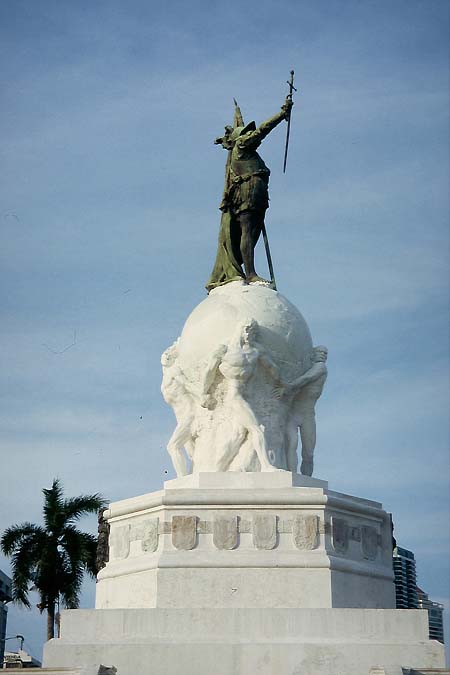 Balboa statue, Panama (WS)
Balboa statue, Panama (WS)
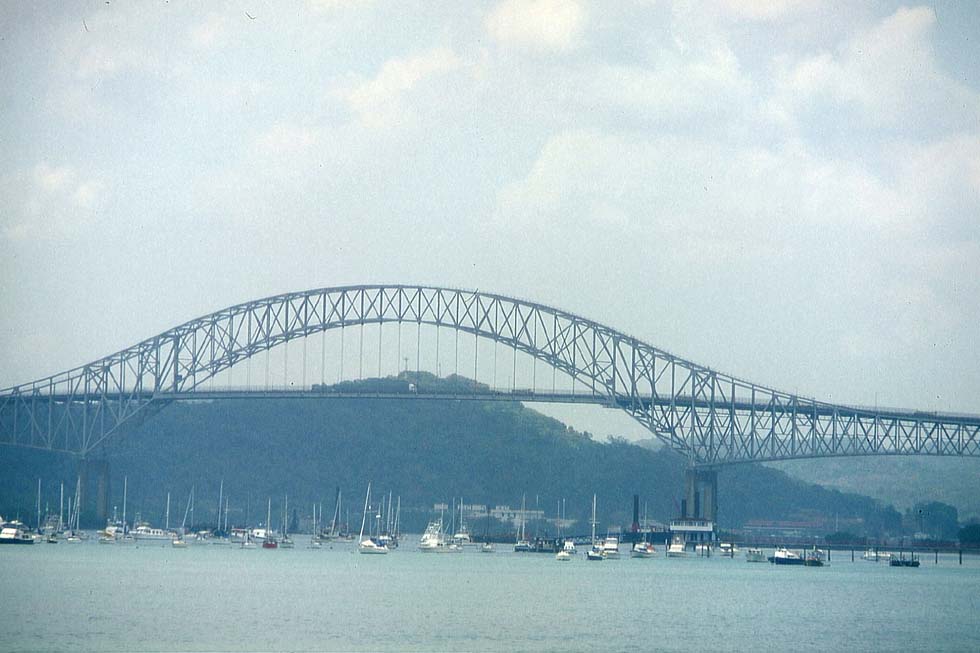
Puente de las Americas, Panama (WS)
Via Panama
Karl V, Emperor of the "Holy Roman Empire" and King Carlos IV of Spain in one person, ordered studies for a canal in 1534 and Alvaredo de Saavedra Colon became the first to make a plan. A project like that however would have been too ambitious for the epoch. Almost three centuries later the German geographer Alexander von Humboldt studied the possibility of a canal through the Isthmus of Panama and Goethe predicted astonishing results for mankind if the canal would form a waterway between the Atlantic and the Pacific Ocean. The idea of creating a sort of railway for transporting ships from the Gulf over the Isthmus of Tehuantepec to the Pacific, published in 1887 by engineer James B. Eads, of course remained a dream. More realistic was the route via Panama, an Idea taken up for the British Australian mail "when, at a public meeting at the London Tavern in 1846 (...) it was resolved to urge on H.M. Government that enquiries should be carried out into the most expedient ways of connecting with Australia by steam. There were then, and for years after, opposing views on the route likely to prove the best. Some were for the Cape of Good Hope route, others across the Isthmus of Panama, and others by the Egyptian Overland Route" (E.A. Ewart).
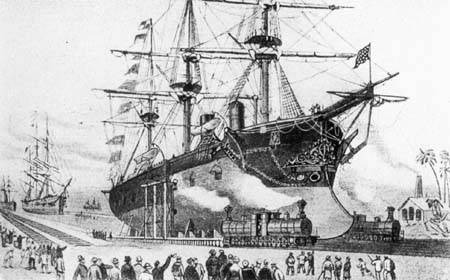 Proposal by James B. Eads (old publication)
Proposal by James B. Eads (old publication)
John M. Maber gives further information: "Prior to 1851, the concept of a trans-Pacific steam service between the United States and Australia had been discussed on occasion in the press and elsewhere but it wasn't until that year that the suggestion was given a boost by the discovery of gold in Australia". In 1852 Burns & Co. proposed a steamship line from New York to the Isthmus of Panama and from Panama to Australia. In the same year the Royal Mail Steam Packet Co. engaged in the West Indies trade and targeting a worldwide traffic, founded the Australasian Pacific Mail Steam Packet Co. in order to start Panama - Australia services, but abandoned the project. In 1853 the New York & Australian Steam Navigation Co. planned a Panama - Sydney service, but made only one voyage with the "Golden Age" from Sydney to Panama in 1854 (then she was sold to the PMSSCo and c. 1875 to the Mitsubishi Shoji Kaisha).
About the screw-steamship "Australian" of the Australian Mail SN Co., unlucky on the Indian Ocean route, J.M. Maber wrote "... that it had been laid down for the Cunard Line as one of four similar steamships for a projected service between Liverpool, New York and Chagres". It had been intended that this route should be worked in connection with services from Panama to San Francisco and ultimately to New Zealand and Australia. As matters turned out however, the projected Chagres service did not materialize. The Chagres is the river on the Isthmus of Panama where during these years the broad-gauge Panama Rail Road was built, the first modern way to connect the Caribbean with the Pacific, fully opened in 1855. Hendschel's Telegraph timetable of March 1856 mentions a twice monthly British mail steamship in connection with the train crossing the isthmus in 3 hours at an extremely high fare of 25 dollar, with connecting services to San Francisco and to Valparaiso. No shipping line to Australia or New Zealand is mentioned and a note informed: "As long as the steamer service between Singapore and Australia is interrupted, the mail from Liverpool to Australia will be dispatched by direct packet boats via the Cape of Good Hope..". R.M. Startup of the Postal History Society of New Zealand informed the author: "From March 1857 postage rates provided for the carriage of mails from New Zealand to England, over the route New Zealand - Melbourne - Suez - Alexandria - Southampton or Alexandria - Marseilles - England, or into Europe via Trieste. This mail would have been carried by rail Suez - Alexandria (...). From May 1866 until December 1868 the bulk of the mail was carried by sea to the Panamanian isthmus, rail overland to the Atlantic coast, where it would have joined other mails to England". It was the Panama, New Zealand & Australia Royal Mail Co., the re-organised Intercolonial Royal Mail Steam Packet Co., which opened the service in 1866 with the 1,501-ton "Kaikoura". The connecting Royal Mail Steam Packet Co. held a stake. Two years later however the uneconomic service was closed down.
From 1872 also completion of a steamer for the Compagnie Generale Transatlantique, intended for services west of Panama, is reported. It was to connect the French islands in the Pacific and passengers from Europe should have used the Panama Rail Road. Opening of the transcontinental railroad through the USA must have been the reason why that first Panama route has had no future. A map of 1904 showed among the trans-Pacific services even a route Wellington - Rio de Janeiro - Plymouth, but not a single one to Panama.
The irregularity of shipping to New Zealand led to formation of the New Zealand Shipping Company at Christchurch in 1873. This N.Z.S.Co. was famous for their fast clipper ships, carrying migrants from England to the colony. The outward passages of the clippers were all made round the Cape of Good Hope and the homeward run was by Cape Horn. E.A. Ewart continued: "The first steamer chartered was the Clyde-built "Stad Haarlem"... The Company was the first to establish a regular line with steamers between England and New Zealand, and in 1884 a mail contract was secured and a monthly service was started". Cook's Timetable of the '90s showed monthly services London - Plymouth - Tenerifa - Cape Town - Hobart - New Zealand ports, back via Montevideo - Tenerifa. In the years before WWI large additions were made to the fleet in vessels of 11,000 tons and more.
Panama Canal
A new age of transoceanic shipping has begun when the Suez Canal after the death of its designer Alois von Negrelli was completed under the management of the French diplomat and engineer Ferdinand de Lesseps in 1869. He founded an international joint-stock company in order to build also the Panama Canal and in 1880/81 construction work was taken up. The impediments by geography and geology for that canal through the isthmus extending over a length of 80 km of hilly country, the lowest point being 95 m above sea level, have been immense. Tropical climate and the death rate by infections made human labour unbearable. In 1889 work was interrupted and Lesseps, disappointed and physically exhausted, died in 1894. In the same year a new company was formed by the French and finally locks were envisioned. Also this project was to fail. An upheaval was supported by the United States and in 1903 Panama became independent from Colombia, thus being in the position to conclude a contract with the USA for a canal. President Theodore Roosevelt was much interested and in 1904 the French privileges were acquired. Coronel William Crawford Gorgas and his medical team defeated fever and malaria, chief engineer John F.l. Stevens organized construction work and he realized the idea of an artificial Gatun lake. Coronel George Washington Goethals, Coronel David Gaillard and their men completed the canal within 10 years at a cost of c. 400 million dollar. On 15th August 1914 the Panama Canal was inaugurated and immediately its strategic importance was proven when Europe - not America - started World War I.
The westbound passage of c.15 hours through the canal to the Pacific begins at Colon. Leaving the Gatun locks, the ship reaches the artificial lake Gatun, 26 m above sea level, where the convoys meet. After 37,8 km it enters the Culebra Cut, 13.7 km long and initially of a width of 92m, later widened to 192 and 222 m. The Pedro Miguel locks and the Miraflores locks beyond the Miraflores lake are situated on the southern, the Pacific side. After 8 to 10 hours the ship arrives at the Panama Bay, surrounded by picturesque islands, the city of Panama in the background.
Bradshaw's list of August 1914 does not yet mention the services through the Panama Canal. In 1916 however, the New Zealand Shipping Co., changed their Cape of Good Hope and Cape Horn route in favour of the Panama route. In the same year the company came under control of the P&O. In the 1920's the New Zealand Shipping Company, the Shaw Savill & Albion Co. and the Commonwealth & Dominion Line offered combined services London - Auckland or Wellington via Panama in 35 to 38 days, much faster than via Suez. In 1929-30 the N.Z.S. introduced ships of the "Rangi" class on the Panama run, the "Rangitiki", "Rangitane" and "Rangitata", black/white vessels of c.16,700 tons with a buff funnel. In 1949 motor ship "Rangitane" (21,867 gt) and her consorts "Rangitoto" and "Ruahine" were built for the London - Panama - Wellington route. The Shaw Savill & Albion Co. used the smaller "Ceramic" (15,896 gt) and "Gothic", built in 1948, on a similar service.
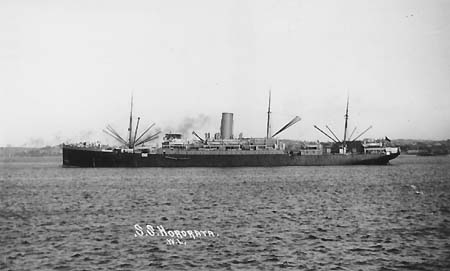
"Hororata" of 1914, NZSSCo., in 1939 sold to British India Line (old card, coll. WS)
|
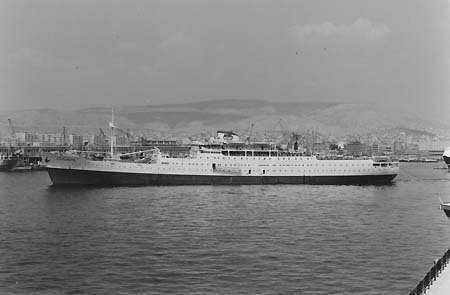
The former "Tahitien" of Messageries Maritimes, as "Atalante" of Med Sun Lines at Piraeus 1978 (WS)
|
From the time after WWI a Java-New York Lijn is reported in connection with the Holland America Line. In 1923 Messageries Maritimes had opened a service through the Panama Canal connecting France with her South Pacific territories Tahiti and Nouvelle Caledonie, combined with a branch line to Sydney. In 1952/53 they employed the motor ships "Caledonien" (12,712 gt) and "Tahitien" on the route Marseilles - Panama Canal - Tahiti - Nouvelle Caledonie - Sydney, but in 1972 the "Tahitien" was sold to Aphrodite Cruises as "Atalante".
Without doubt the greatest and most impressive ocean liner having passed the Panama Canal has been the "Queen Elizabeth 2". The larger "Queen Mary 2", a 'post-Panamax' giant, could not pass the Canal before refurbishment, timed for 2014-15. Until completion of the new locks, passengers of the QM2 could enjoy an excursion on the rebuilt standard-gauge Panama Canal Railroad, opened in 2001. With refurbishment of the canal, the railway, intended mainly for container transport, was called into question.
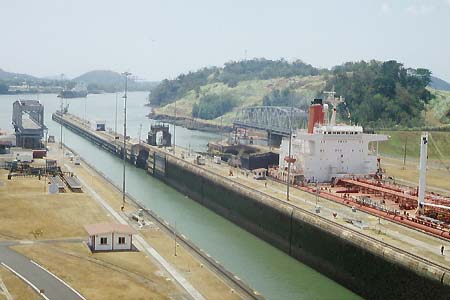 Miraflores locks, Panama, 2006 (WS)
Miraflores locks, Panama, 2006 (WS)
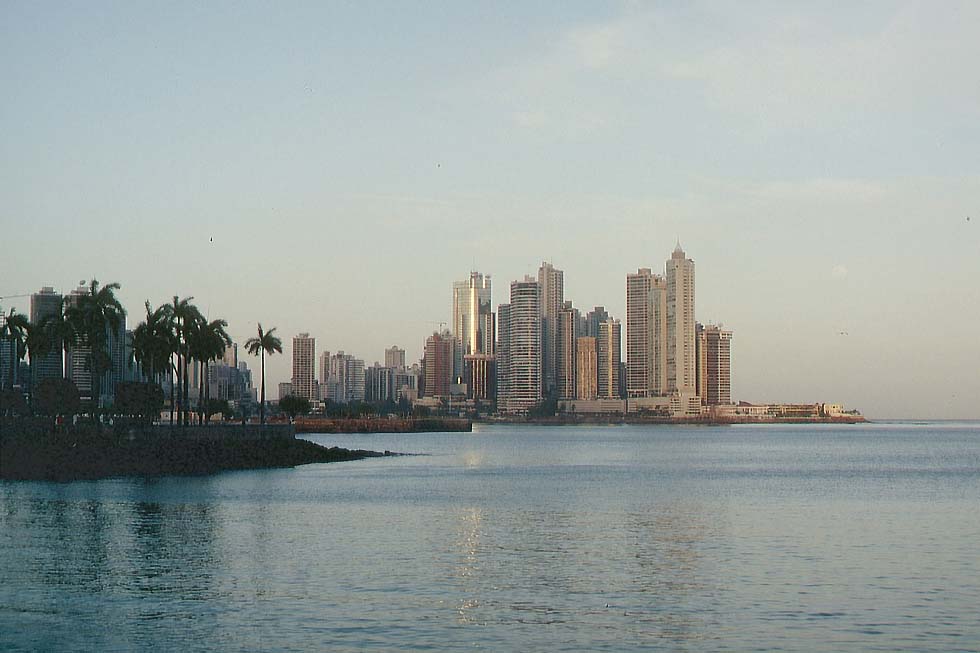
Panama (WS)
USA - Australia
Two events enabled to establish a transcontinental route through the USA: Texas and California became member states of the Union in 1848 and the civil war ended in 1865. In 1869 for the first time a train connected Omaha, Nebraska, with Oakland, California, from where passengers could proceed by steam ferry across the bay to San Francisco.
The American land and sea route gained in interest for the British Australian mail towards 1873 when the federal states Victoria and New South Wales squabbled for providing the terminal of the P&O steamers. "To gain this object, New South Wales fought for a service across the Pacific and America, and Victoria for one by the Red Sea and Ceylon", reported E.A. Ewart. The Australian Mail finally continued to take the way via Suez.
About the New Zealand mail, R.M. Startup informed: "Until the 1870's, much of the mail was handled in conjunction with mail from the Australian colonies (...). From August 1870 a portion of the mail traveled by marine post office to San Francisco, thence by rail to New York, and thence across the Atlantic". In 1870 the governments of New South Wales and of New Zealand agreed to subsidize a mail route by the existing Australasian SN Co. under the trademark American Australian Line in conjunction with the North Pacific Transportation Co. which operated a San Francisco - Honolulu service. The "Wonga Wonga" and "City of Melbourne" were employed on services from Sydney and the "Idaho" and "Ajax" from San Francisco to Honolulu. In 1871 they continued services as California, New Zealand & Australia Mail SS Co., but two years later the vessels were disposed of to the Pacific Mail Steamship Co. known under its abbreviation PMSSCo, of the USA. Nevertheless another company, the Australasian & American Mail SS Co. took over the trans-Pacific services in 1874 and transferred them in 1875 to the PMSSCo in association with Sir William Pearce of John Elder shipyard and Lawrence, Clark & Co., who advertised an Australian Overland Mail Service. It started in 1875 on a route from San Francisco alternatively to Sydney or to New Zealand ports. In 1885 however the PMSSCo withdrew and the other ships under British flag were sold to the Oceanic Steam Ship Co. of San Francisco, which was awarded a mail contract together with the Union Steam Ship Co. of New Zealand.
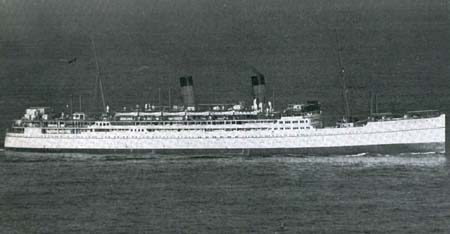 "Aorangi" of 1925 (Union SS Co. of New Zealand)
"Aorangi" of 1925 (Union SS Co. of New Zealand)
The Union Steam Ship Company was formed in 1875, initially for local services. About the further development, E.A. Ewart wrote: "The Union obtained a mail contract to San Francisco in 1885 (...). The trade which the Union had initiated across the Pacific to San Francisco, calling at Honolulu, and which from 1885 had carried on a mail service jointly with an American line, was brought to an end in 1900. In that year the annexation of Hawaii by the United States brought those islands within the American 'coast-wise' laws, which prohibited any but American ships form trading between American ports (...). In 1910, a new service was opened, substituting Tahiti for Honolulu. (...). In 1913 the famous "Niagara" of 13,415 tons was built and put on the trans-Pacific run. She was the first steamer in the world to be granted a Board of Trade certificate for burning oil fuel instead of coal". The San Francisco route without calling at Honolulu however proved to be uneconomic and in 1936 the Union Royal Mail Line closed it down.
The Oceanic Steam Ship Co. or Oceanic Line had entered the San Francisco to Honolulu trade in 1882 and extended services under the new contract to Auckland and Sydney in 1885. After an interruption, the Sydney service was resumed in 1909, being praised as the American & Australian Line, cutting traveling time between London and Sydney to 30 days. In 1926 control passed to the rivaling Matson Line, founded in 1882 by Captain William Matson. Under the trade mark Matson-Oceanic Line arrived in 1931 and 1932 respectively the new luxurious steamers "Mariposa" II and "Monterey" of c. 18,000 tons each in the San Francisco - Sydney service, reducing traveling time by two days. After interruption by WWII in 1940/41, Sydney services were resumed not before 1956, now with converted Mariner class cargo vessels, the "Monterey" II and "Mariposa" III of c. 15,000 tons, on a route San Francisco - Los Angeles - Bora Bora - Tahiti - Rarotonga - Auckland - Sydney - Noumea - Suva - Naivafo'ou - Pago Pago - Honolulu - San Francisco. In 1970 the operations were confined to cruises. From 1960 and 1961 the "Oriana" and "Canberra" of P&O on their round-the-world tours were the most prominent ships on the Pacific.
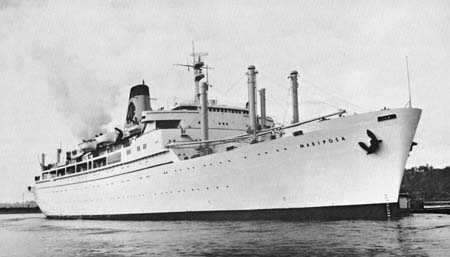 "Mariposa" (III), reg. for Oceanic SS Co. (Matson Lines)
"Mariposa" (III), reg. for Oceanic SS Co. (Matson Lines)
Canada - Australia
The route Vancouver - Sydney, via Honolulu and the Fiji Islands, was served monthly by the Canadian & Australian Steamship Line, started by James Huddart in 1893, purchased by the Union SS Co. of New Zealand in 1910 and then renamed Canadian Australian Royal Mail Steamship Line. An advertisement listed the "Makura", "Moana", "Aorangi", "Manuka" and "Marama". During World War I the Australian Mail was carried on that Vancouver - Victoria - Honolulu - Fiji - Auckland - Sydney route by the "Niagara" and the smaller "Makura", but also on the competing San Francisco route and further on by rail to the Atlantic. In 1931 the Canadian Pacific purchased an interest in the Canadian Australasian. Services ended when their last steamer, the "Aorangi" II (17,491 gt), 32 years old, was laid up in 1953.
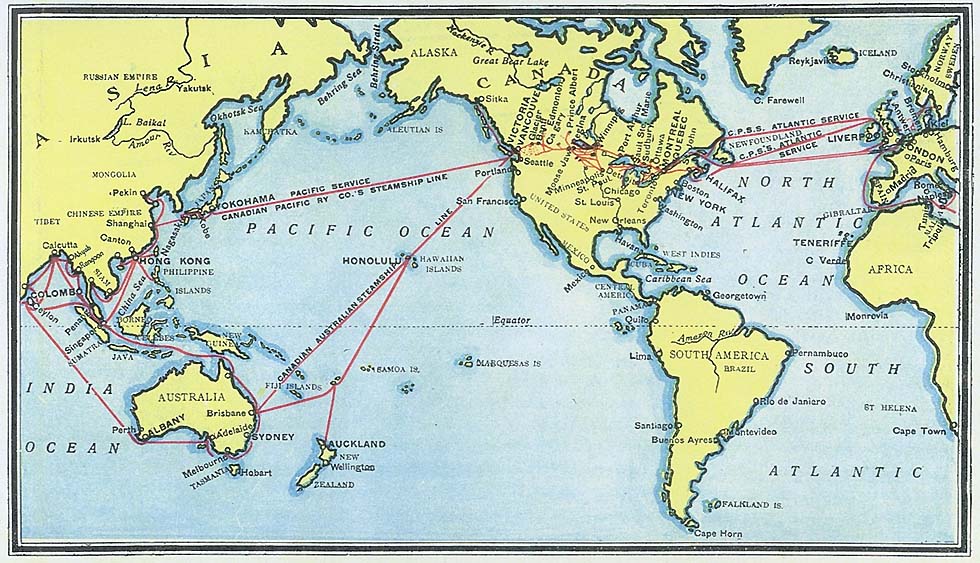
Canadian Pacific ad (coll. William Pearce)
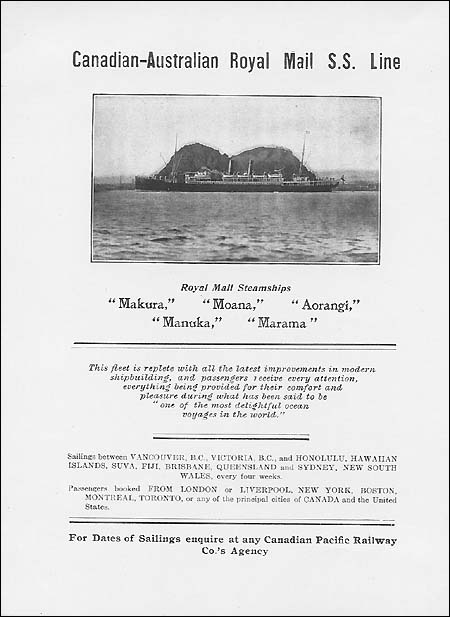 CP ad (coll. WS)
CP ad (coll. WS)
From 1954 the Orient Line filled the gap with an experimental Orient & Pacific Lines service Sydney - Auckland - Vancouver - San Francisco, started with the "Oronsay" II (20,001 gt, built in 1925), followed in 1958 by the P&O. In that year the "Himalaya" III ( 1949/ 27,955 gt) opened this service with a voyage Sydney - Auckland - Suva - Honolulu - Vancouver - San Francisco. In 1959 the return journey via Yokohama and Singapore was added. Further Pacific sailings followed with the "Arcadia" (1953/ 29,734 gt), half-sister "Iberia" and the 24,215-ton "Chusan" (III), which had been completed in 1950 for the Far Eastern trade, kept to the Far East/ Pacific until 1963. The P&O story continued with the round-the-world sailings via USA and the Panama Canal - see chapter Panama-Australia.
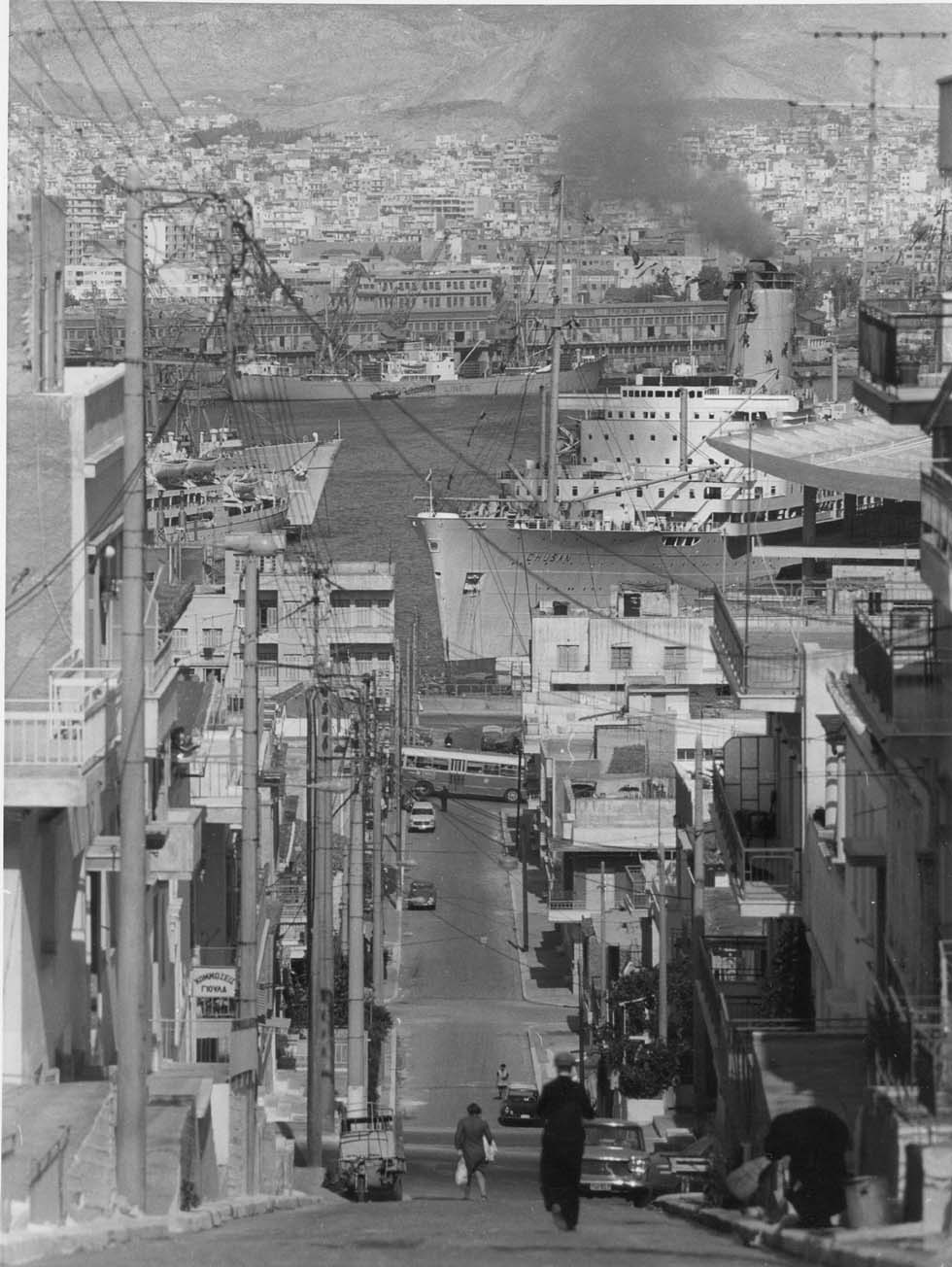
"Chusan" (III) of P&O, Piraeus 1970 (WS)
Round-the-World
When airlines gradually replaced regular passenger shipping on the Pacific, some companies changed to round-the-world routes. The two most astonishing ships on those services were the "Southern Cross" (20,204 gt) of 1955 and the "Northern Star" (24,731 gt) of 1962. With engines and funnel aft instead of midships, they revolutionized passenger ships' architecture. They are a brainchild of Lord Sanderson, chairman of Shaw, Savill & Albion. These ships were laid out for 1,160 tourist class passengers and no longer for the traditional cargo transport, thus avoiding delays. With a light-grey hull and white superstructure they showed also a new colour scheme. The buff funnel of the "Northern Star" was later changed to dark green with a yellow star.
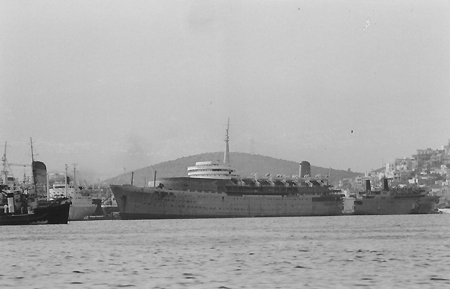 The former "Southern Cross", as "Calypso" at Perama 1974 (WS)
The former "Southern Cross", as "Calypso" at Perama 1974 (WS)
The S.M. Nederland undertook round-the-world voyages with the "Johan von Oldenbarnevelt" and the "Oranje". In 1959 the "Willem Ruys" of the Rotterdam Lloyd started a Rotterdam - Suez - Sydney - Panama - Rotterdam circuit, closed down in 1964. It was areplaced in 1965 by a round-the-world route of the Holland America Line, using the "Ryndam" and the "Maasdam" (c. 15,000 gt) of 1951 and 1952.
In 1960 P&O Orient Lines were united as a holding. In that year the modern "Oriana" of Orient Line and in 1961 the "Canberra" of the P&O were inaugurated on Southampton - Suez - Sydney - Auckland - USA - Panama - Southampton circuits on both directions, from 1966 running exclusively under the label P&O. After the Suez Canal was blocked from 1967, the Cape route had to be chosen.
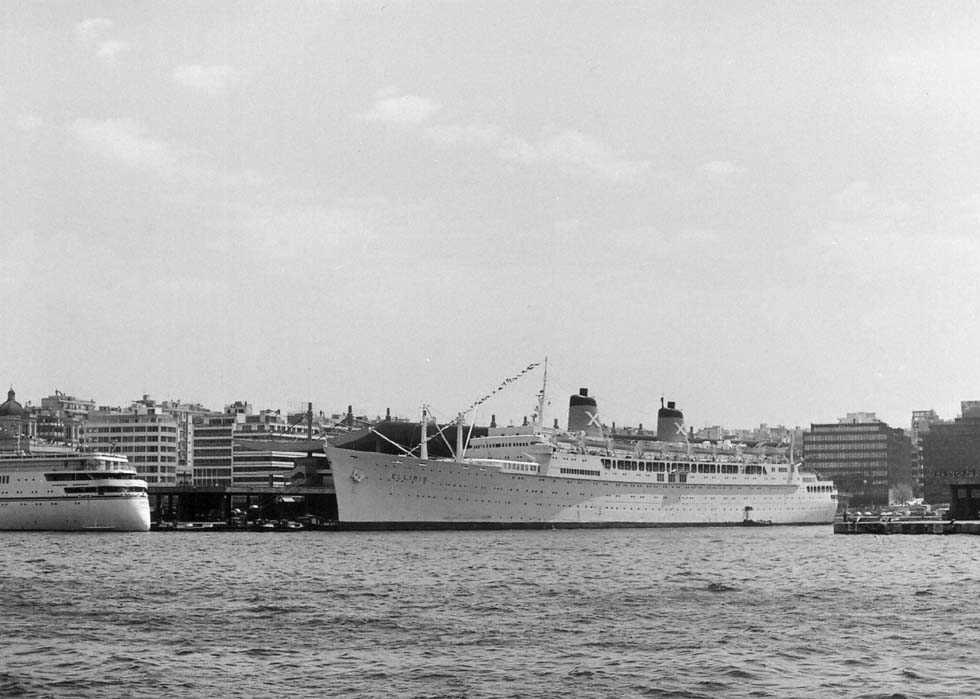
"Ellinis" of Chandris, ex "Lurline" (II) of Matson, Piraeus 1978 (WS)
Also the Cogedar Line with the motor ships "Aurelia" and "Flavia", Chandris with the "Australis" (ex "America") and "Ellinis" (ex "Lurline" II) and even the USSR followed with regular round-the-world services via Panama. ABC Shipping Guide showed for 1978/79 the Soviet routes Southampton - Panama - Sydney, Sydney - Rio de Janeiro - Southampton and Southampton - Suez - Sydney, offered under the CTC Lines label, with the motor ship "Taras Shevchenko" (20,027 gt). After Cunard's "Caronia" of 1948 made yearly similar round-trips, the most prestigious liners on trans-Pacific round-the-world tours and almost the only ones calling also at Vancouver, had been the "Oriana" and the "Canberra" of P&O. Then the liners gave way to cruises, but still towards the end of the 70s, Princess Cruises with the "Island Princess" and "Pacific Princess" (see main chapter Cruises) was listed as a regular service provider Los Angeles - Sydney.
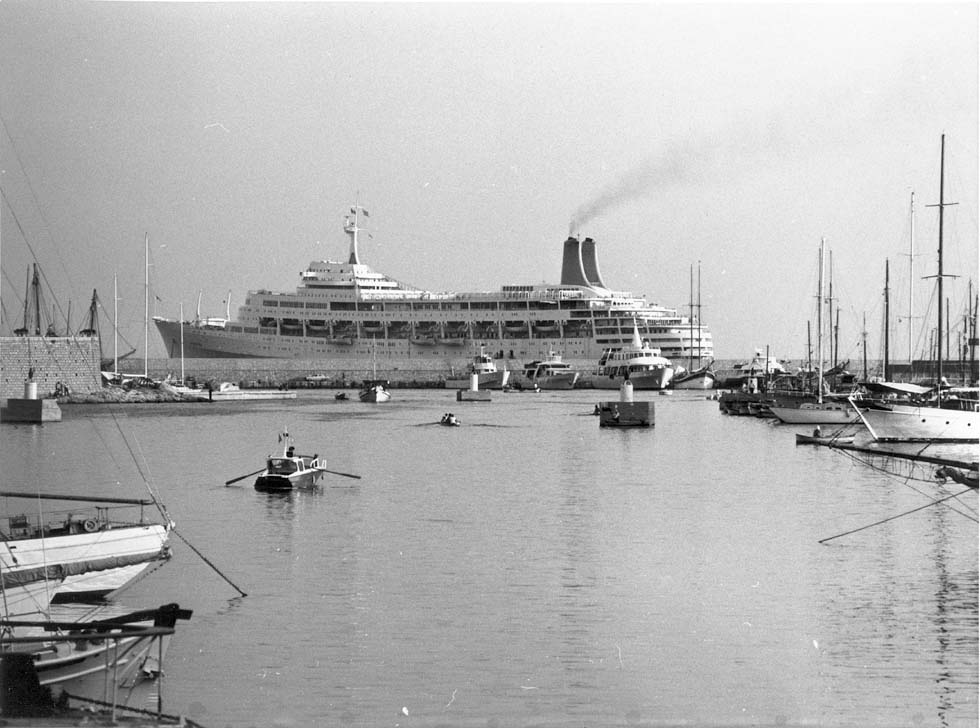
"Canberra" off Pasolimani, Piraeus 1974 (WS)
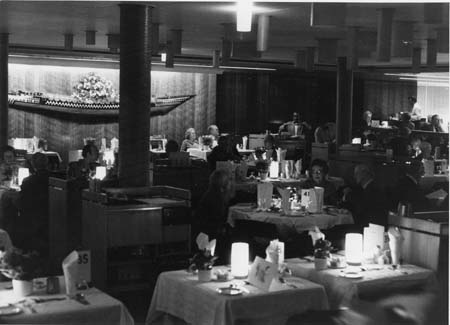
"Canberra", Pacific Restaurant, 1979 (WS)
|
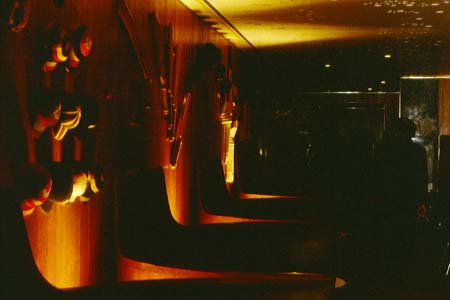
"Canberra", a lounge (WS)
|
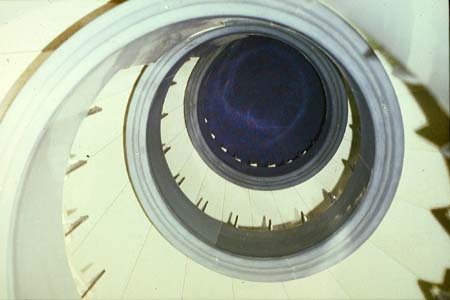
"Canberra", Atrium staircase (WS)
|
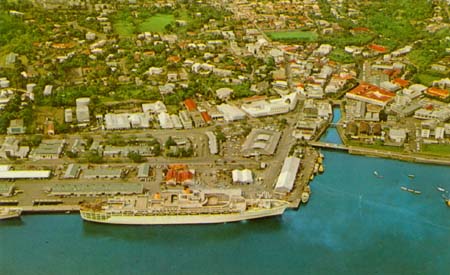
"Oriana" at Suva, Fidji Islands (old card, coll. WS)
|
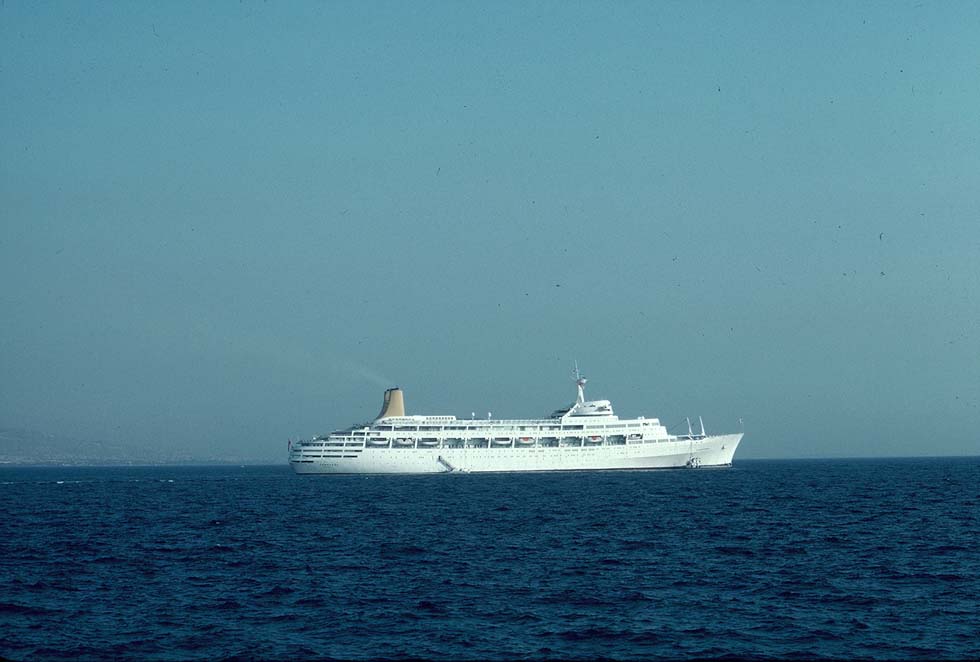
"Canberra" at Faliron Bay, Greece (WS)
|